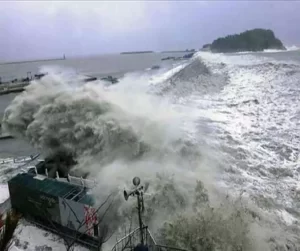Table of Contents
1. Types of Earthquake
The types of earthquakes are as follows:
a. An Aftershock is a weaker earthquake that took place after a preceding large earthquake, in a similar location to the mainshock.
b. A blind thrust earthquake is an earthquake that took place along a thrust fault that does not provide a mark on the Earth’s surface.

c. Cryoseism is a seismic incident that may be occurred by a quick cracking action in frozen soil or rock saturated with water or ice.

d. Deep focus earthquake also known as a plutonic earthquake, is an earthquake with a hypocenter depth of more than 300 kilometers (190 mi) Doublet earthquake – Multiple earthquakes with at least similar waveforms originating from the same location.
e. Earthquake swarm, events where a local area experiences sequences of many earthquakes striking in a relatively short period of time.
f. A foreshock is an earthquake that occurs before a larger seismic event (the mainshock) and is related to it in both time and space.
g. Harmonic earthquake is a sustained emit of seismic and infrasonic energy typically related to the underground displacement of magma, the venting of volcanic gases from magma, or both.
h. Induced seismicity, typically minor earthquakes and tremors that are caused by human activity that alters the stresses and strains on the Earth’s crust Interplate earthquake, an earthquake that took place at the boundary between two tectonic plates Intraplate earthquake, an earthquake that took place within the inside of a tectonic plate.

i. A Megathrust earthquake is an earthquake taking place at subduction zones at devastating convergent plate boundaries, where one tectonic plate is forced below another.
j. The triggered earthquakes, are an outcome of the effects of large earthquakes at a significant distance, outside of the quick aftershock zones.
k. A slow earthquake is a discontinuous, earthquake-like event that emits energy over a time of hours to months, rather than the seconds to minutes property of a typical earthquake.
l. A submarine earthquake may be defined as an earthquake that took placed underwater at the base of a body of water, majorly in an ocean.
m. A supershear earthquake is an earthquake in which the propagation of the rupture along the fault surface took place at speeds in excess of the seismic shear wave (S-wave) velocity, creating a result analogous to a sonic boom.
n. Strike-slip earthquake is an earthquake where two tectonic plates sliding past each other get caught, build tension, then slide free, creating an earthquake.
o. Tsunami earthquake, is an earthquake that triggers a tsunami of a magnitude that is very much larger than the magnitude of the earthquake as measured by shorter-period seismic waves.

p. Volcano tectonic earthquake is an earthquake-induced by the movement (injection or withdrawal) of magma.
These were our 16 types of earthquakes.
| Read Also: Earthquake Terminology |

